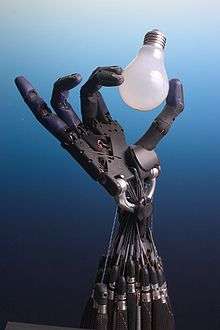Soft robotics
Soft robotics is a sub-field of robotics that deals with non rigid robots constructed with soft and deformable materials like silicone, plastic, fabric, rubber, or compliant mechanical parts like springs. Soft robots can actively interact with the environment and can undergo “large” deformations relying on inherent or structural compliance due to their softness and other morphological features.
Aspects
Soft robots are often, but not necessarily, bio-inspired. They have a number of advantages over rigid robots. For example, deformable structures play an important role for robots that have to deal with uncertainty and highly dynamic tasks and environments, for example, locomotion in rough and unknown terrain or grasping of unknown objects. Also safety plays a role when considering soft material in the design of robots as softness allows for safe physical contact with living cells and human bodies. In addition, deformable material and structures like springs are potentially able to store and release energy, which is beneficial for energy efficient locomotion. Another advantage of soft robotics is that the used materials are much cheaper than metal parts and high-torque servos employed in classical robotic systems.
A disadvantage of soft robotics is that their soft structures are difficult to model and, therefore, hard to control. Furthermore, since the field is quite young, most of soft robots are in the prototype stage and still have to demonstrate to be useful under real-world conditions or for industrial applications.
Technologies and techniques
- Pneumatic artificial muscles
- Phase-change materials could allow robots to switch between hard and soft states.[1]
Scientific community
Although people have been using soft material for robots for a long time, only recently an international community has been formed. For example, since October 2012 exists an IEEE RAS Technical Committee on Soft Robotics, which coordinates the international community around this field of research. In 2013 the International Journal on Soft Robotics was funded. It publishes quarterly results from the field. In October 2013 started RoboSoft – A Coordination Action for Soft Robotics funded by the European Commission under the 7th Framework Programme, Future and Emerging Technologies (FET) Open Scheme. The goal of the project is to consolidate the international scientific community of scientists and roboticists working in the field of soft robotics.
International journals
- Soft Robotics (SoRo) (http://www.liebertpub.com/soro)
- Soft Robotics section of Frontiers in Robotics and AI (http://journal.frontiersin.org/journal/robotics-and-ai/section/soft-robotics)
International events
- 2016 First Soft Robotics Challenge, April 29–30, Livorno, Italy
- 2016 Soft Robotics week, April 25–30, Livorno, Italy
- 2015 "Soft Robotics: Actuation, Integration, and Applications - Blending research perspectives for a leap forward in soft robotics technology" at ICRA2015, Seattle WA
- 2014 Workshop on Advances on Soft Robotics, 2014 Robotics Science an Systems (RSS) Conference, Berkeley, CA, July 13, 2014
- 2013 International Workshop on Soft Robotics and Morphological Computation, Monte Verità, July 14–19, 2013
- 2012 Summer School on Soft Robotics, Zurich, June 18–22, 2012
In popular culture
The 2014 Disney film Big Hero 6 revolved around a soft robot, Baymax, originally designed for use in the healthcare industry. In the film, Baymax is portrayed as a large yet unindimidating robot with an inflated vinyl exterior surrounding a mechanical skeleton. The basis of the Baymax concept come from real life research on applications of soft robotics in the healthcare field, such as roboticist Chris Atkeson's work at Carnegie Mellon's Robotics Institute.[2]
See also
References
- ↑ Phase-changing material could allow even low-cost robots to switch between hard and soft states
- ↑ Trimboli, Brian (Nov 9, 2014). "CMU's soft robotics inspire Disney's movie Big Hero 6 - The Tartan". The Tartan. Carnegie Mellon University. Retrieved 2016-08-15.
